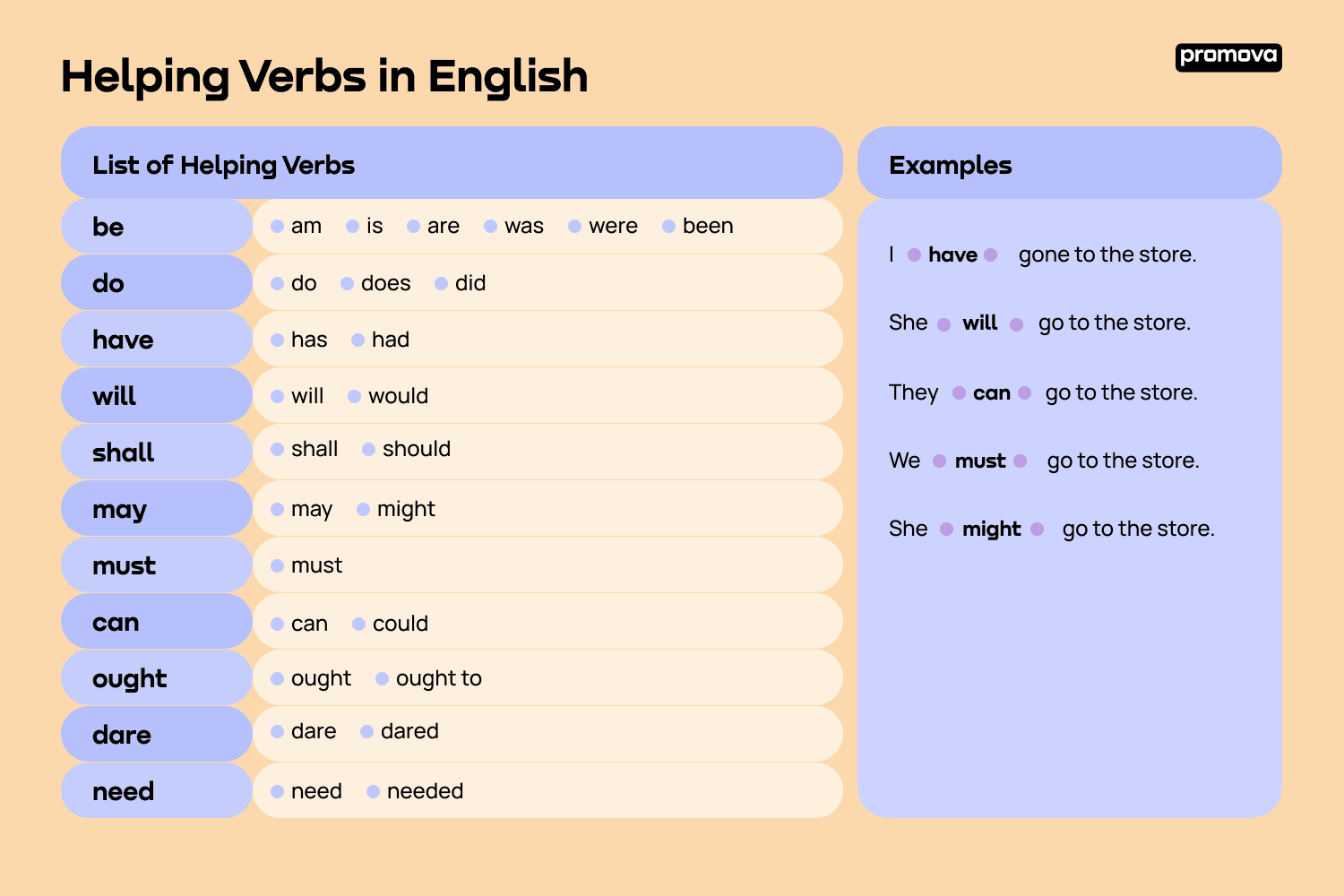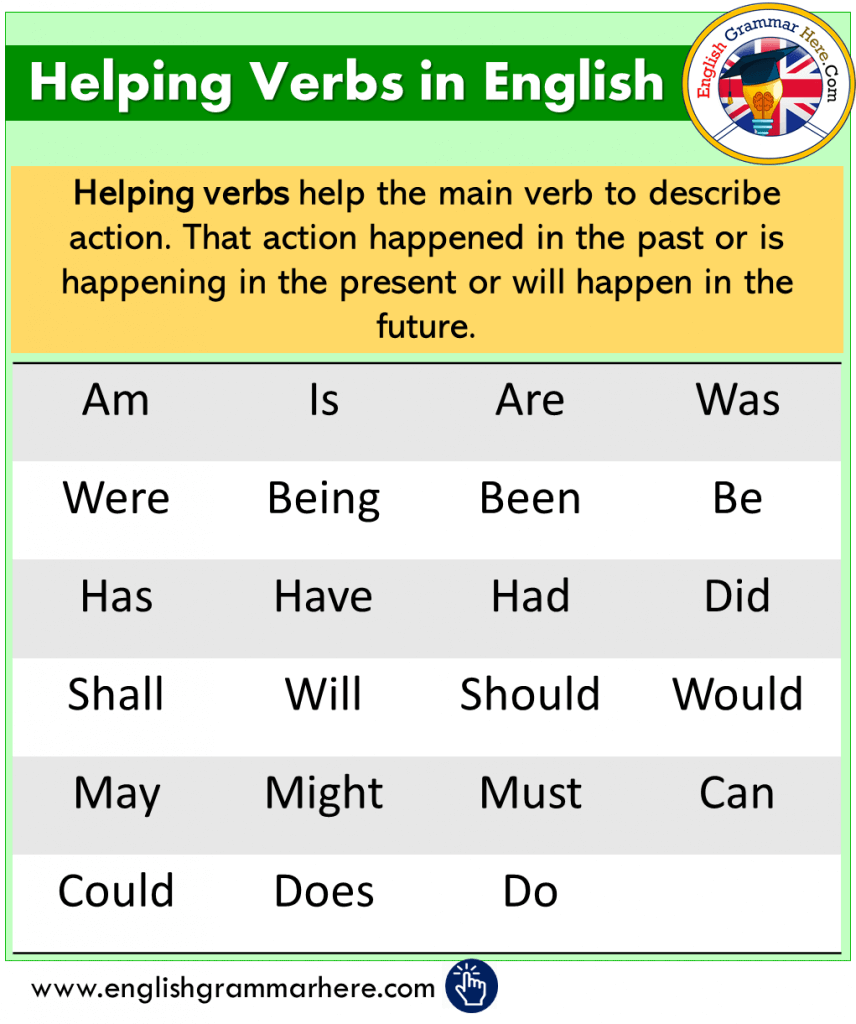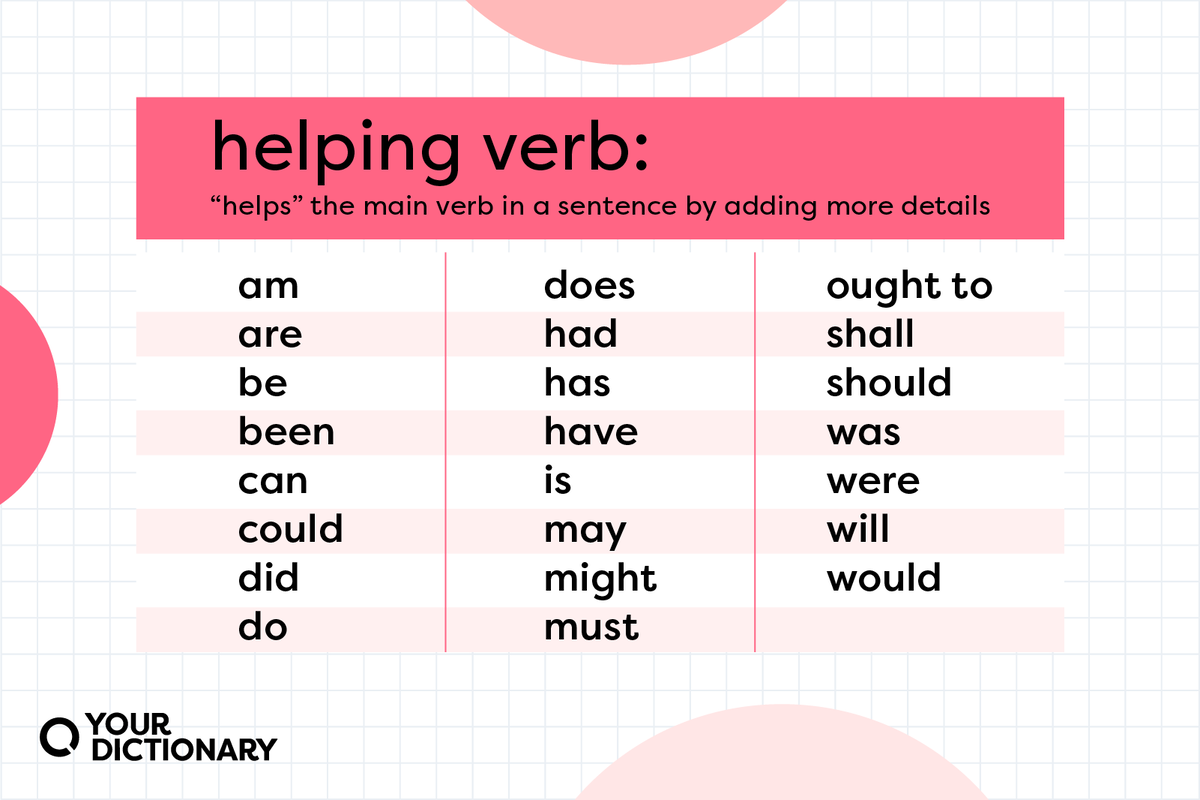
What Is Être Helping Verb? 6 Most Correct Answers
Definition of a Helping Verb A helping verb is "a verb (as am, may, or will) that is used with another verb to express person, number, mood, or tense", according to the Merriam-Webster Dictionary. How to Use Helping Verbs with Examples?

Helping Verbs YouTube
Auxiliary Verb: DO. The helping verb 'do' can also act as a full verb only in positive sentences. When do is used in a negative sentence, it is an auxiliary verb. The helping verb 'do' is also used to make questions for most verbs except other auxiliary verbs and the modal verbs. "Do" is an irregular verb that changes its form.

Helping verb Helping verbs, English vocabulary, Vocabulary
What are Helping Verbs or Auxiliary Verbs? Helping verbs, also known as auxiliary verbs, are words that come before the main verb in a sentence and provide additional meaning. They can indicate tense, aspect, or mood. Common helping verbs include "be" (am, is, are), "have" (has, had), "do " (does, did), and "will" (shall, should).

Main and Helping Verbs
Helping verbs are also called "auxiliary verbs". Helping verbs have no meaning on their own. They are necessary for the grammatical structure of a sentence, but they do not tell us very much alone. We usually use helping verbs with main verbs. They "help" the main verb (which has the real meaning). There are only about 15 helping verbs in.

Helping Verb Promova Grammar
Helping Verb vs. Action Verb Helping Verb Quiz Helping Verb Type 1: Auxiliary Verbs Auxiliary verbs help express verb tense in a sentence. The three most common auxiliary verbs are to be, to have, and to do — and all of their verb forms. to be - am, is, are, was, were, be, been, being to have - have, has, had, having to do - do, does, did

Auxiliary Verbs English Study Here
What are helping verbs? Helping verbs, also called "auxiliary verbs," are verbs that don't have a specific definition by themselves, but instead "help" the main verb of the sentence. A lot of English learners make mistakes with helping verbs in English, so here's a complete guide to using this type of verb! Helping Verbs List. Basic.

Helping Verbs
The helping verb are indicates the present tense, and adds a sense of continuity to the verb finding. He has given his all. Has is a helping verb used in expressing the tense of given. The following table provides a short list of some verbs that can function as helping verbs, along with examples of the way they function..

helping verbs song YouTube
A helping verb (also known as an auxiliary verb) is used with a main verb to help express the main verb's tense, mood, or voice. The main helping verbs are "to be," "to have," and "to do." They appear in the following forms: To Be: am, is, are, was, were, being, been, will be To Have: has, have, had, having, will have To Do: does, do, did, will do

Improving Your Grammar with Helping Verbs
In terms of linking and helping verbs: Helping verbs help establish certain facts about a sentence, often when they are happening in time. Like the example in the video, "Brian is eating a pizza," the helping verb helps place this action in the present progressive (it's happening right now). For linking verbs, the "to be" form serves as a way.

Helping Verbs, Meanings and Examples in English English Grammar Here
Auxiliary verbs, also known as helper verbs or helping verbs, are minor verbs that support the sentence's main verb to communicate complex grammar concepts like aspects of time or modality. For example, in this sentence, "I have finished the report," the auxiliary verb have supports the main verb finish.

English Auxiliary Verb, Helping Verbs, Definition and Example Sentences; Table of Contents
A helping verb is a verb that combines with a main verb to form a verb phrase. Sometimes it is also called a verb marker, because it indicates that a verb is to follow. In a sentence with one main verb in the simple present tense, it's typically easy to identify the verb by looking for the action word. For example: Jim walks quickly.

Am, Is, Are, Do, Does worksheet Helping verbs, Verbs review, English as a second language (esl)
Helping verbs, also known as auxiliary verbs, are used for many reasons in English. They allow us to construct sentences and questions and to demonstrate times. They also help us to differentiate between active and passive voice and question tags.

Helping Verbs in English Helping verbs help the main verb to describe action. That action
Helping verbs are used in front of other verbs to express different tenses, moods, and more. Learn more about helping verbs with our lists and examples!

Helping verbs list in English with Bangla Helping verbs
A helping verb, also known as an auxiliary verb, is a verb that accompanies the main verb in a sentence to provide additional meaning or to indicate tense. Unlike main verbs, helping verbs don't convey action but lend support to the main verb to form different tenses, voices, or moods. What is the best Example of a Helping Verb Sentence?

Helping Verbs Meaning, Types, and Examples YourDictionary
On the other hand, the function of a helping verb is to indicate at what time the action took place. Helping verbs vs. action verbs. Helping verbs are also referred to as auxiliary verbs and are used along with the main verb in a sentence to represent the mood, voice, or tense of the main verb. Some examples of the main helping verbs are as.

Auxiliary verbs (Helping verbs) English grammar lesson YouTube
Below you will learn about the most common helping verbs and how they're used. You'll notice that many helping verbs are used in specific verb tenses. The tense of a verb tells us the time period when an action occurs, such as in the present, past, or future. You'll learn more about this concept in Lesson 8. To be: am, is, are, was, were, be.